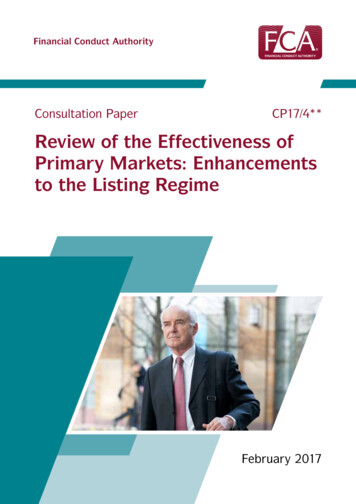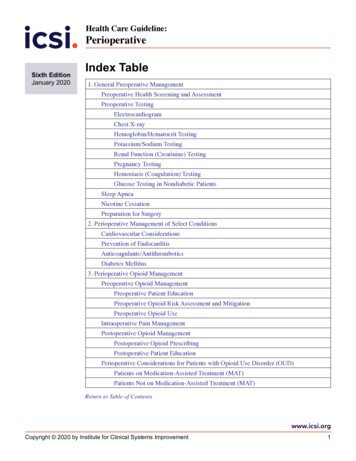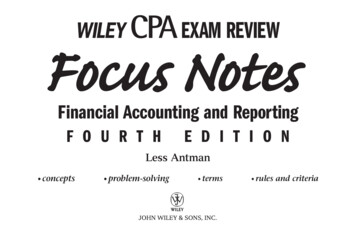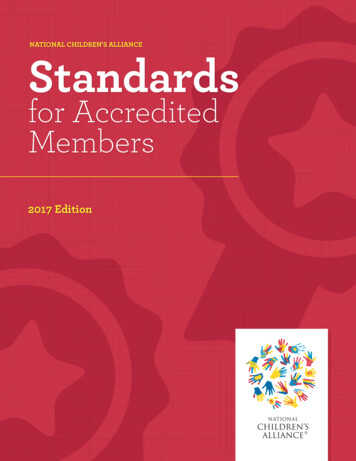
Transcription
Financial Conduct AuthorityConsultation PaperCP17/4**Review of the Effectiveness ofPrimary Markets: Enhancementsto the Listing RegimeFebruary 2017
Review of the Effectiveness of Primary Markets:Enhancements to the Listing RegimeCP17/4ContentsAbbreviations used in this paper31Overview52Clarifications to Chapter 6 of theListing Rules113Concessionary routes to premium listing164Classifying transactions for premiumlisted issuers18Suspensions of listing for reverse takeovers245Annexes1List of questions302Cost benefit analysis333Compatibility statement39Appendix12345Technical notes for consultation onclarifications to Chapter 6 of theListing Rules41Technical notes for consultation onconcessionary routes to premium listing46Technical Note for consultationon classifying transactions51Technical notes for consultation oncash shells, special purpose acquisitioncompanies and reverse takeovers55Draft Handbook text61Financial Conduct AuthorityFebruary 20171
We are asking for comments on this Consultation Paper by 14 May 2017.You can send them to us using the form on our website at: www.fca.org.uk/cp17-04-response-formOr in writing to:Primary Markets PolicyFinancial Conduct Authority25 The North ColonnadeCanary WharfLondon E14 5HSTelephone:Email:020 7066 1684cp17-04@fca.org.ukWe have developed the policy in this Consultation Paper in the context of the existing UK and EUregulatory framework. We will keep the proposals under review to assess whether any amendmentsmay be required in the event of changes in the UK regulatory framework, including as a result of anynegotiations following the UK’s vote to leave the EU.We make all responses to formal consultation available for public inspection unless the respondent requestsotherwise. We will not regard a standard confidentiality statement in an email message as a request fornon-disclosure.Despite this, we may be asked to disclose a confidential response under the Freedom of Information Act2000. We may consult you if we receive such a request. Any decision we make not to disclose the responseis reviewable by the Information Commissioner and the Information Rights Tribunal.You can download this Consultation Paper from our website: www.fca.org.uk. All our publications areavailable to download from www.fca.org.uk. If you would like to receive this paper in an alternativeformat, please call 020 706 0790 or email: publications graphics@fca.org.uk or write to: Editorial andDigital team, Financial Conduct Authority, 25 The North Colonnade, Canary Wharf, London E14 5HS.
Review of the Effectiveness of Primary Markets:Enhancements to the Listing RegimeCP17/4Abbreviations used in this paperCBAcost benefit analysisCPConsultation PaperDPDiscussion PaperFCAFinancial Conduct AuthorityFSAFinancial Services AuthorityFSMAFinancial Services and Markets Act 2000GAAPgenerally accepted accounting principlesIPOinitial public offeringLRListing Rules sourcebookMARMarket Abuse Regulation (Regulation (EU) No 596/2014)PBTprofit before taxSPACspecial purpose acquisition companySRBCscientific research based companyUKLAUK Listing AuthorityFinancial Conduct AuthorityFebruary 20173
Review of the Effectiveness of Primary Markets:Enhancements to the Listing RegimeCP17/41.OverviewIntroduction1.1The Financial Conduct Authority (FCA) has the overarching strategic objective of ensuringmarkets function well. An important part of that is ensuring the UK’s primary markets remaineffective.1.2Primary markets play a key role in supporting the wider economy by bringing together investorsseeking investment opportunities and issuers that want to access deep and liquid pools ofcapital to finance their businesses. We have an important role in ensuring the UK’s primarymarkets remain effective in meeting both these needs.Background1.3In our 2016/17 Business Plan, we said we would carry out a review of the structure of the UK’sprimary markets to ensure that they continue to serve the needs of issuers and investors. Theoverall outcome we want to achieve is an increase in the efficiency and effectiveness of primarymarkets to ensure they meet those needs1. We are now publishing two documents to progressthis aim.1.4Firstly, we are publishing a Discussion Paper (DP) that considers the broader market landscapeand sets out a number of areas where we want to explore opportunities for structuralenhancements to UK primary markets. The DP is entitled ‘Review of the Effectiveness ofPrimary Markets: The UK Primary Markets Landscape’ and has been published on our website2.The second document we are publishing is this Consultation Paper (CP), which sets out moredeveloped proposals to enhance certain aspects of the Listing Rules. While the CP and DP areseparate and different in nature, they complement each other and many stakeholders in theprimary markets will want to read both.1.5The proposals in this CP take into account the stakeholder feedback we have received as partof our review of the UK’s primary markets and address issues that have emerged from ourinteractions with issuers and their advisors on transactions. The proposals aim to ensure thatthe Listing Rules continue to meet the needs of issuers and investors, and most relate to thepremium segment of the listing regime. As the proposals are primarily technical, we thinkit is appropriate to address them now, and that this does not affect the broader, high-leveldiscussion set out in the -plan-2016-17.pdf (page dfFinancial Conduct AuthorityFebruary 20175
Review of the Effectiveness of Primary Markets:Enhancements to the Listing RegimeCP17/41.6In addition to the CP and DP, we are currently working on, or have completed, a number ofother workstreams which are relevant to our policy aims in the primary markets. Some of thesehave helped shape the proposals in this paper. These are: Our investment and corporate banking market study, which concluded with the publicationof a Final Report (MS15/1.3) in October 20163 Our work contributing to the negotiation of the new Prospectus Regulation (PD3) Our work with market participants to look at options for improving the availability ofinformation in the UK initial public offering (IPO) process, which we will shortly consult on,and Our work to improve the effectiveness of the UK’s primary debt markets to better meet theneeds of issuers and investors, including through the UK Debt Market Forum, as explainedin our report ’Practical measures to improve the effectiveness of UK primary listed debtmarkets’4Stakeholder discussions and views1.7Our discussions with stakeholders so far have provided strong endorsement for the UK’spremium listing regime. However, they have also identified some areas for further technicalenhancement. We have similarly become aware of potential improvements through our recentexperiences working with sponsors advising on transactions in our capacity as the UK ListingAuthority (UKLA).1.8We are therefore proposing amendments to the Listing Rules to ensure that certain provisionsthat apply to premium listing remain effective and appropriately calibrated. This will involve anumber of changes to our Handbook and supporting guidance (including in UKLA technicalnotes that we publish on the FCA’s website) to clarify, simplify or reduce unnecessary regulatoryrequirements. While these proposals will primarily benefit issuers with, or applying for, apremium listing, they may also benefit some issuers with a standard listing. We discuss thisfurther below.1.9There are three groups of proposals in this CP. These cover: The requirements in Chapter 6 of the Listing Rules which apply to commercial companiesapplying for a premium listing of their shares. The treatment of transactions that are outside the ordinary course of business and whichare, or are proposed to be, undertaken by listed issuers. These changes involve the socalled ‘class tests’, used to assess the size of the transaction relative to the listed issuer, andspecifically the ‘profits test’5. Our approach to suspending the listing of an issuer that has announced a reverse takeover,or where details of such a transaction have es/ms15-1-3-final-report.pdfSee our report on the UK Debt Market Forum at: t-markets.pdf.4R, Annex 1 to Chapter 10 of the Listing RulesFebruary 2017Financial Conduct Authority
Review of the Effectiveness of Primary Markets:Enhancements to the Listing Regime1.10CP17/4We have summarised these changes below.Who does this consultation affect?1.11This CP will be of particular interest to: UK and overseas companies that have listed equity securities or certificates representingequity securities, or are considering a UK listing of such securities firms advising on the issuance of UK listed equity securities or certificates representingequity securities firms or persons investing or dealing in UK listed equity securities or certificates representingequity securitiesIs this of interest to consumers?1.12This paper will be of interest to consumers who deal and invest in UK listed shares eitherdirectly or through institutions. It will also be of interest to issuers in their capacity as consumersof sponsor services.Summary of our proposals1.131.141.15Clarifications to the premium listing eligibility requirements for commercialcompaniesChapter 6 of the Listing Rules (LR 6) sets out the requirements an applicant has to meet inorder to obtain a premium listing. We have amended this chapter a number of times. While thepremium listing eligibility requirements are strongly endorsed by stakeholders, our discussionsidentified several areas where the rules could provide greater clarity on what is required.We are therefore making a range of proposals to present the existing requirements more clearlyand ensure the drafting better reflects the intention of the rules and how they are applied inpractice. We are also proposing new technical notes with additional guidance to give greatercontext to the rules.Changes to the concessionary routes to premium listingAs well as redrafting sections of LR 6, we are also proposing changes to what are known as the‘concessionary routes’ to premium listing. Applicants for premium listing are usually requiredto have a three-year revenue earning track record in order to be eligible for premium listing.However, there are specific rules for companies in some sectors which exempt an applicantfrom this requirement. Instead, they enable it to gain a premium listing by complying with otherconditions (the ‘concessionary routes’).Financial Conduct AuthorityFebruary 20177
Review of the Effectiveness of Primary Markets:Enhancements to the Listing RegimeCP17/41.16In this CP, we propose a new concessionary route to premium listing for certain propertycompanies that cannot meet the LR 6 track record requirements. The proposed new concessionwould recognise that a property valuation report might be considered as a more appropriateway to judge the maturity of a property company when assessing its eligibility for premiumlisting.1.17We have also looked at the existing concessionary routes to premium listing to assess if they arestill up to date and comprehensive enough. We have decided that they are still appropriate, andso are not proposing any substantial changes to these provisions. However, we have decided thatthey would benefit from new guidance in some areas to ensure they are properly understood.As a result, we are consulting on two new technical notes and replacing an existing one withnew content. These are set out in Appendix 1.1.18Classifying transactions – changes for premium listed issuersThe obligation for premium listed issuers to provide certain disclosures or seek shareholderapproval for large transactions that are outside the ordinary course of business (typicallyacquisitions, disposals and joint ventures) is an important feature of the governance requirementsand shareholder protections imposed by the Listing Rules. To establish whether these obligationsapply, the Listing Rules require proposed corporate transactions to be classified according toa number of tests of relative size. These tests are known as the ‘class tests’. The classificationof a transaction (unclassified, class 2 or class 1) determines whether a premium listed issuermust make certain disclosures on the transaction and whether it will have to seek shareholderapproval. The classification will also indicate whether the transaction is a reverse takeover.1.19To ensure the regime is effective, the method for assessing the size of a transaction must beclear and result in appropriate classifications. However, stakeholder feedback and our ownexperience dealing with requests from issuers and their advisors for individual guidance onthe application of the class tests suggests that one of the class tests - the ‘profits test’ - oftenproduces anomalous results.1.20We have carefully considered the feedback we have received, and now propose two changesto the profits test: That premium listed companies will be permitted to disregard an anomalous profits testresult of 25% or more when all of the other class test results are below 5%, and That premium listed issuers will be permitted in certain limited circumstances to makespecified adjustments to the profit figures used in the profits test without first seeking ouragreement.1.218These would apply where the transaction would otherwise be classed as a class 1 or reversetakeover and the issuer has obtained the guidance of a sponsor under LR 8.2.2R in relation tothe application of the Listing Rules on classifying the transaction. As part of this, we proposeto update the guidance in our separate Technical Note (UKLA/TN/302.1) on adjusting the profitfigures.February 2017Financial Conduct Authority
Review of the Effectiveness of Primary Markets:Enhancements to the Listing Regime1.221.23CP17/4We are also proposing certain adjustments to the figures used to classify assets and profits.Currently, these figures must be those in the latest published audited consolidated accounts orpreliminary statement (or subsequently published interim balance sheet), which are adjustedto take account of subsequently completed transactions that meet or exceed the threshold fora class 2 transaction. We are now proposing to amend the rules to require the figures usedfor classifying assets and profits to be adjusted for such transactions completed during thelast financial year. While this approach is currently set out in a separate Technical Note (UKLA/TN/302.1), we think it would be more appropriate to include it explicitly in the Handbook itself.Reverse takeoversA reverse takeover is a transaction where the business, company or assets being acquired(which we refer to as the ‘target’) is or are bigger than the listed issuer (based on the results ofthe class tests), or where the transaction results in a fundamental change in the business, boardor voting control of the issuer. We refer to this as a reverse takeover because the entity being‘taken over’ becomes the major part of the combined business.1.24Our approach to date has been to assume that, where a reverse takeover is in contemplation,there will be insufficient information in the market about the target unless the listed companycan provide it. The information that will generally satisfy us that a suspension is not required isspecified in the Listing Rules and is broadly equivalent to that required to be disclosed to themarket on a listed company. Where the information is not provided, our view has historicallybeen that the market will not operate smoothly and we will often use our powers to suspendthe issuer’s listing, until either the ‘information gap’ is bridged or the issuer confirms that thereverse transaction is no longer in contemplation.1.25However, in response to stakeholder feedback and our own experience with reverse takeovers,we propose to change our approach. Under our proposals, the assumption of insufficientinformation being available in the market will no longer apply. Instead we will assume thatthe market can operate smoothly on the basis of the information that listed companies alreadymake publicly available as part of their compliance with existing obligations, principally theobligation to disclose inside information under the Market Abuse Regulation (MAR).1.26The proposed change also addresses stakeholder feedback that suspending a listing is adisproportionate action which harms investors because it means they cannot trade in thesecurities of the acquiring party, potentially for a long period of time. Stakeholders have told usthat issuers want to avoid any possibility of this kind of detriment, but are concerned they maynot be able to give us the specific information we need to decide not to suspend their listing.Feedback suggests that this has the practical effect of deterring some issuers from pursuingtransactions altogether.1.27However, we propose keeping our existing approach for shell companies. By shell companieswe mean issuers whose assets consist wholly or predominantly of cash or short dated securities,or whose predominant objective is to undertake an acquisition or merger (e.g. special purposeacquisition companies (SPACs)). This is because different considerations apply to shell companies.1.28Our proposals do not include changing the premise in LR 5.6.19G that we will generally seekto cancel an issuer’s listing when it completes a reverse takeover. They also do not includechanging or removing our general power to suspend listing in LR 5.1.1R and the relatedguidance in LR 5.1.2G.Financial Conduct AuthorityFebruary 20179
Review of the Effectiveness of Primary Markets:Enhancements to the Listing RegimeCP17/4Equality and diversity considerations1.29We have considered the equality and diversity issues that may arise from the proposals in thisCP. Overall, we do not consider that our proposals adversely impact any of the groups withprotected characteristics (i.e. age, disability, sex, marriage or civil partnership, pregnancy andmaternity, race, religion and belief, sexual orientation and gender reassignment).1.30We will continue to consider the equality and diversity implications of the proposals during theconsultation period, and will revisit them when publishing the final rules.1.31In the interim we welcome any input to this consultation on such matters.Next steps1.321.331.3410What do you need to do next?We welcome your views on the questions and proposals put forward in this paper. Please sendyour responses to us by 14 May 2017.How?Use the online response form on our website or write to us at the address on page 3.What will we do?We will consider your feedback and publish our rules in a Policy Statement in the second halfof 2017.February 2017Financial Conduct Authority
Review of the Effectiveness of Primary Markets:Enhancements to the Listing RegimeCP17/42.Clarifications to Chapter 6 of the Listing RulesIntroduction2.1In this chapter we propose amendments to Chapter 6 of the Listing Rules (LR 6), the chapterwhich deals with the eligibility requirements for premium listed companies. This is to make therules in LR 6 clearer and more transparent.2.2Stakeholders have provided us with strong feedback that the premium listing segment workswell, and that we should not disturb the equilibrium the current rules achieve between theneeds of investors and issuers. However, we have amended LR 6 several times over the years,and as a result the drafting has, in places, become difficult to interpret.2.3We therefore propose to reorder the chapter and amend provisions to simplify and clarify theexisting provisions, giving market participants a better understanding of the premium listingeligibility requirements. These amendments are not intended to create significant changes inunderlying policy, but should make the premium listing process more efficient and effectiveby being more transparent, consistent and accessible. We also propose substantive changes toa small number of rules and propose to add and delete a small number of rules and guidanceprovisions. We explain these further below.2.4In certain cases we consider it necessary to explain the operation of rules further throughadditional guidance, which we think sits best in our Knowledge Base 6 of technical and proceduralnotes on the Listing Rules, Prospectus Rules and Disclosure Guidance and Transparency Rules.As a result, we propose a number of new technical notes, set out in Appendix 1 to this paper.Depending on consultation feedback, we will add these to the Knowledge Base in due course.6Our source of technical guidance on the FCA’s Listing Rules, Prospectus Rules and Disclosure Guidance and Transparency Rules,published on our website at al Conduct AuthorityFebruary 201711
Review of the Effectiveness of Primary Markets:Enhancements to the Listing RegimeCP17/4Summary of proposed amendments2.52.6We have also amended the drafting to clarify that a company that is an applicant for premiumlisting by virtue of it being inserted as a new top holding company of an existing premium listedgroup (so-called ‘new topco’ transactions) and which is also undertaking a transaction will notnecessarily be treated as an applicant for premium listing to whom LR 6 applies. This will onlybe the case where the transaction is a reverse takeover.2.7Likewise, we have clarified that LR 6 does not apply to further issues of shares of the classalready listed unless this occurs in conjunction with a reverse takeover.2.8In ‘reordering’ LR 6, we have re-designated the original provisions into new provisions and thenamended, deleted or restated the text. We have also created new rules in the process2.92.102.1112Where LR 6 appliesWe propose a revised section to better explain to whom LR 6 applies, and also propose toupdate the rules to refer consistently to ‘applicant’ (some rules previously referred to ‘newapplicant’). As a result, the ‘new applicant’ definition in the Handbook’s Glossary of Terms(Glossary) is no longer required and we propose to delete it.Requirement for historical financial informationCurrently in LR 6.1.3R, we set out that a new applicant for premium listing must have publishedor filed certain historical financial information. We propose to state explicitly (in LR 6.2.4R) thatthe additional financial information (which may be required where there have been acquisitionsduring the three year track record period) needs to be audited. This is currently only implicit inthe rules.The track record requirementsLR 6 requires an applicant for premium listing to demonstrate a three-year financial track recordthat is representative of the business to be listed. This ensures that businesses demonstrate acertain level of maturity in order to be eligible for premium listing. While the three-year trackrecord requirement is long-established and continues to have broad stakeholder support, recentcases have made clear that issuers can find it difficult to understand when their track recordmeets the requirements of the rules, and for sponsors to advise their clients with confidence.We propose to clarify the drafting of the requirements, currently in LR 6.1.3BR to LR 6.1.3EG(LR 6.2.1R to LR 6.3.2G in the proposed new rules), and make it clearer that only a companythat has been generating revenues in its declared line of business for the past three financialyears can demonstrate that it is eligible for premium listing. We propose to do this by insertinga clear reference to revenue generation in LR 6.3.1R(1), whereas currently it appears only in theassociated guidance. We also propose to provide an additional Technical Note, UKLA/TN/102.1,with further guidance on how to interpret the track record requirements.February 2017Financial Conduct Authority
Review of the Effectiveness of Primary Markets:Enhancements to the Listing RegimeCP17/42.12We also propose to delete the guidance set out in LR 6.1.13G to LR 6.1.15G which explainswhere we might waive the requirement for financial information and a track record. As we donot normally waive these requirements, we consider that an explicit reference to our willingnessto do so is misleading.2.13We also propose further amendments to some of the track record rules for readability andclarification purposes. As well as updating the financial track record requirements and therelated cross-references, we have also clarified that the requirement for a revenue earningtrack record does not apply to a mineral company. Further, we are proposing that formineral companies that have been in existence for less than three years, the requirement forrepresentative historical financial information only applies to the period for which a mineralcompany publishes or files its historical financial information.The independence requirementsIn 2012 to 20147, we consulted on enhancing the requirements in LR 6 relating to theindependence of an issuer’s business, focusing particularly on three areas:2.14 The listed company’s business should be a standalone business. It should be independentand able to implement its business strategy without relying on a third party to generate itsbusiness. Where there is a controlling shareholder, the relationship with the controlling shareholdershould be appropriate – recognising nevertheless that a large holding will rightly confersignificant voting rights. The board of the company should be able to control the company’s business. This maynot be possible when, for example, a company’s only assets are minority holdings in otherentities.2.15The changes at that time were triggered by suggestions in the market that a small numberof companies with dominant controlling founder shareholders, often from jurisdictions withcorporate governance traditions different from the UK’s, were being run more like private thanpublic companies, and that the interests of minority shareholders were being disregarded. Atthe same time, the consultation process recognised that the UK tradition of ‘one share - onevote’ should be maintained, and that minority shareholders should not be able to control acompany, meaning that a majority shareholder would naturally have significant influence, givenits majority of voting rights in the company.2.16We continue to regard our requirement to demonstrate an independent business as important.The current rules are structured as a single overarching requirement, with guidance that givesan illustration of circumstances where this requirement might not be met. However, our recentdiscussions with market participants have shown that this structure has unintentionally obscuredthe meaning of the rule, and risked businesses applying the guidance inappropriately. So toclarify these requirements we propose to state more explicitly which factors within the existingguidance apply to which of the three areas mentioned above by splitting out the current rulesinto three sections. This split should clarify, for example, that a majority shareholder exercisingvoting rights does not necessarily impede the issuer’s freedom to implement its businessstrategy.7See CP12/25, CP13/15 and PS 14/8Financial Conduct AuthorityFebruary 201713
Review of the Effectiveness of Primary Markets:Enhancements to the Listing RegimeCP17/42.17Our proposal involves splitting the existing independence rule, LR 6.1.4R, into three separateprovisions: a rule on the need to carry out an independent business per se (LR 6.4) a rule that clarifies the need to have a business independent of any controlling shareholder(LR 6.5), and a rule that clarifies the issuer must control its business (LR 6.6)2.18We also propose some accompanying guidance (LR 6.4.3G, LR 6.5.3G and LR 6.6.3G) that setsout factors that may indicate the issuer does not comply with the rules.2.19We further propose to insert guidance (LR 6.4.2G, LR 6.5.2G, LR 6.6.2G) to make the purposeof the rules more explicit, namely that the protections afforded to shareholders under theListing Rules must be meaningful.2.20As this is an area that requires difficult judgements to be made, we also propose to supplementthe relevant Handbook provisions with a new Technical Note, UKLA/TN/103.1, to help interpretit. In particular, we propose that this Technical Note gives examples of what might be seen asimproper influence.2.212.222.2314Working capitalWe propose to delete the guidance in LR 6.1.17G and LR 6.1.18G. This states that we maydispense with the requirement in LR 6.1.16R for an applicant for listing, and any subsidiaryundertakings, to have sufficient available working capital to meet the group’s requirements forat least the next 12 months (proposed LR 6.7.1R). We have not waived this requirement sincethe listing function was conducted by the FCA or its predecessor, the FSA, and are unlikely todo so in future. As a result, we consider that the current guidance is no longer appropriateConstitutional arrangementsWe propose explicitly stating in LR 6 that an issuer’s constitution must allow it to comply withthe Listing Rules, and have grouped rules that relate to the issuer’s constitution in one section,LR 6.9.1R to LR 6.9.2R, for ease of reference.Other consequential changesFinally, we propose consequential changes to several chapters of the Listing Rules and theGlossary to ensure they include appropriate cross-references to LR 6.2.24There are proposed cross-reference amendments to LR 5, LR 8, LR 9, LR 11, LR 13, LR 15, LR 16and the Fees Manual.2.25Given the more tightly drafted application of LR 6, we have updated the cross-reference in LR8.4.2R and LR 8.4.8R to refer to the working capital statement in the document provided withthe listing application, rather than specifically referring
1.1 The Financial Conduct Authority (FCA) has the overarching strategic objective of ensuring markets function well. An important part of that is ensuring the UK's primary markets remain effective. 1.2 Primary markets play a key role in supporting the wider economy by bringing together investors










